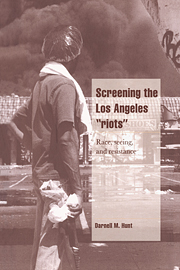Book contents
- Frontmatter
- Contents
- List of figures
- List of tables
- Preface
- 1 Introduction
- Part I Context and text
- Part II Audience
- 4 Stigmatized by association: Latino-raced informants and the KTTV text
- 5 Ambivalent insiders: black-raced informants and the KTTV text
- 6 Innocent bystanders: white-raced informants and the KTTV text
- Part III Analysis and Conclusions
- Postscript
- Appendix A Data and methods
- Appendix B Figures
- Appendix C KTTV Transcript
- Appendix D Questionnaires
- Appendix E Tables
- Notes
- References
- Index
5 - Ambivalent insiders: black-raced informants and the KTTV text
Published online by Cambridge University Press: 23 January 2010
- Frontmatter
- Contents
- List of figures
- List of tables
- Preface
- 1 Introduction
- Part I Context and text
- Part II Audience
- 4 Stigmatized by association: Latino-raced informants and the KTTV text
- 5 Ambivalent insiders: black-raced informants and the KTTV text
- 6 Innocent bystanders: white-raced informants and the KTTV text
- Part III Analysis and Conclusions
- Postscript
- Appendix A Data and methods
- Appendix B Figures
- Appendix C KTTV Transcript
- Appendix D Questionnaires
- Appendix E Tables
- Notes
- References
- Index
Summary
I would just say that, to me, there's not a riot. It's a rebellion. It's not only a rebellion against the verdict that was handed down – the not guilty verdicts. But it was also a rebellion against the way black people are treated in this country.
(black-raced informant)Unlike the term “Latino,” “black” is an unambiguous racial label in the United States. The US Census Bureau, for example, employs the label to denote a specific raced group – African Americans. Among members of this group, the label is often an expression of solidarity, of shared heritage, of the shared discrimination and oppression they experience at the bottom of the US racial order (see Jaynes and Williams 1989). Indeed, the above quote is a reflection of this understanding.
As we saw in chapter 3, “blacks” – unlike “Latinos” – were prominent in the KTTV text as interviewees and event participants. In fact, they were depicted as event insiders, those either responsible for the events or best positioned to persuade event participants to “do the right thing” and cease participation. At first glance, this insider status appears to be the natural outgrowth of the cause of the events. These events did, after all, erupt directly following media announcements of the not-guilty verdicts in a high-profile police brutality case, one in which an “all-white” jury exonerated four white-raced police officers in the beating of a black-raced motorist (i.e., see chapter 3, assumption 4).
- Type
- Chapter
- Information
- Screening the Los Angeles 'Riots'Race, Seeing, and Resistance, pp. 77 - 100Publisher: Cambridge University PressPrint publication year: 1996



